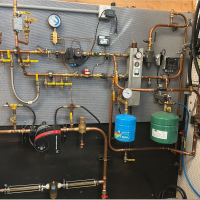Welcome! Here are the website rules, as well as some tips for using this forum.
Need to contact us? Visit https://heatinghelp.com/contact-us/.
Click here to Find a Contractor in your area.
Best Of
Re: Zone valve failure
I think those valves have a 20 psi shut off pressure, I doubt that 007 would push them open, even deadheaded?
Did someone remove one of the springs on the HW valves? That is a common hack if you ever had water hammer. That would lessen the valves close off pressure and you could leak past and erode away the brass.
A delta P circ is what I would replace that 007 with. It will modulate the pressure based on one, two, or no zones open. Amnd reduce electrical consumption!
Did someone remove one of the springs on the HW valves? That is a common hack if you ever had water hammer. That would lessen the valves close off pressure and you could leak past and erode away the brass.
A delta P circ is what I would replace that 007 with. It will modulate the pressure based on one, two, or no zones open. Amnd reduce electrical consumption!
 hot_rod
hot_rod
1
Re: Is a radiant barrier the new round earth?
@EdTheHeaterMan Questioning if the earth is really roundish and if radiant barriers are real or if science in general has any validity are in vogue. There are people who think birds are fake. LOL I was asking if we have reached the point of understanding that radiant barriers are as questionable as the spherical nature of our singular spaceship home.
 Teemok
Teemok
1
Re: Heat loss calculation and sizing radiant runs
I'm a big proponent of 6" on center spacing. You get better output, faster recovery, and more even temperature across the floor surface.
6" can be done with 1/2" pex. 3/8" is easier to work with, certainly for DIYers. . I'd go 200- 225' with 3/8"
You can get either in a 1-1/4" mudset. Staple the loop ends well, that is where it tends to want to pop up.
Are your floor joist up to the task of that extra weight? Nothing worse for tile than a bouncy floor
6" can be done with 1/2" pex. 3/8" is easier to work with, certainly for DIYers. . I'd go 200- 225' with 3/8"
You can get either in a 1-1/4" mudset. Staple the loop ends well, that is where it tends to want to pop up.
Are your floor joist up to the task of that extra weight? Nothing worse for tile than a bouncy floor
 hot_rod
hot_rod
2
Re: Which new boiler to choose?
what size is the current boiler
how is your dhw load
A 110 might be adequate, but the 155 would recover the indirect faster. If that is a concern
how is your dhw load
A 110 might be adequate, but the 155 would recover the indirect faster. If that is a concern
 hot_rod
hot_rod
1
Re: Replumbing: Solder or Threads for Ball Valves
Wave soldering has been a thing since the 60's or so.
Yes, it's usually performed by machines now because they're better and faster at it. But, repairs are still done by hand.
1
Re: Lamp wick and dope
They all get the job done, generally. Its more of a Pride of craftsmanship & style thing to differentiate yourself: ' I'm a Burnham Man...Riello guy...Megaloc..." ad nauseum. Any Pipe dope that smells like Petroleum (Permatex, et cetera) I would not recommend on domestic water joints. Mad Dog 🐕
Re: issue with converted gas power burner
Seems from here for the moment the problem is fuel supply problem , gas pressure readings will be needed . From the hip does the problem burner run ok if the sister unit is off ?
 Big Ed_4
Big Ed_4
3
Re: Biasi vs Typical Pin-Style
Actually Bob...
All systems will run at 140 degrees - and do!
They operate at all temperatures from ambient to the limit setting. 75% of the time they run around 140° because the stat is satisfied by the time it gets there (like this spring e.g. here in NJ) as well as well over that in dead of winter when 140 will be the lowest temps during an off cycle.
A zillion other factors come into play but I'd bet you'd be amazed at how many boilers in NJ actually have a seasonal average water temperature of 140° or even less!
I support the AFUE standard wholeheartedly. Both for typical hot water systems and radiant as well.
All the whiners who lament the AFUE standard are the ones who think it unfare because they can't meet a number based on the standard.
keep in mind something many do not understand or even want to (for selfish reasons), the water temperature is at the outlet. Not the return. Also realize the boiler water temperature has little to do with the stack temperatures and condensing.
True, they are "related" but we have seen boilers with water temps at 200 and stack temps at 140 and also seen water temps at 140 and stack temps at 300+.
Just because a boiler runs with 140° water temps does NOT assure it will condense in the flue (or inside the boiler either!)
To Learn More About This Professional, Click Here to Visit Their Ad in "Find A Professional"
All systems will run at 140 degrees - and do!
They operate at all temperatures from ambient to the limit setting. 75% of the time they run around 140° because the stat is satisfied by the time it gets there (like this spring e.g. here in NJ) as well as well over that in dead of winter when 140 will be the lowest temps during an off cycle.
A zillion other factors come into play but I'd bet you'd be amazed at how many boilers in NJ actually have a seasonal average water temperature of 140° or even less!
I support the AFUE standard wholeheartedly. Both for typical hot water systems and radiant as well.
All the whiners who lament the AFUE standard are the ones who think it unfare because they can't meet a number based on the standard.
keep in mind something many do not understand or even want to (for selfish reasons), the water temperature is at the outlet. Not the return. Also realize the boiler water temperature has little to do with the stack temperatures and condensing.
True, they are "related" but we have seen boilers with water temps at 200 and stack temps at 140 and also seen water temps at 140 and stack temps at 300+.
Just because a boiler runs with 140° water temps does NOT assure it will condense in the flue (or inside the boiler either!)
To Learn More About This Professional, Click Here to Visit Their Ad in "Find A Professional"
1
Re: Help with one-pipe boiler heating system
If the other radiators on that zone are cast iron baseboard, you would be wise to use the same for your addition. Cast iron has a much higher thermal mass than fin tube. If you mix the two types in one zone, the rooms with fin tube will tend to underheat.
Since additions are often built and insulated differently from the main building and have a different heating load profile, it's usually best to put them on their own zone. In that case you could use fin tube in the addition.
Since additions are often built and insulated differently from the main building and have a different heating load profile, it's usually best to put them on their own zone. In that case you could use fin tube in the addition.
 bburd
bburd
1
Re: Help with one-pipe boiler heating system
Normally a monoflow tee is installed on the baseboard return and a regular tee is put on the supply.
But it will work with the monoflow on the supply and a regular tee on the return as long as the monoflow tee is in the correct orientation.
If your heat loss for this room is 15,000 btus or less (about 27' of total baseboard) then 1/2" copper should be ok. Anything over that should be 3/4"
The reason you have 3/4 baseboard on 1/2" Monoflo system is that 3/4 baseboard is much more common....and the supply houses only want to stock 1 size. 1/2" fin tube is available but most do not stock it.
The monoflow tees and regular tees are sized based on the room heat loss and the btus of the baseboard connected to it.
But it will work with the monoflow on the supply and a regular tee on the return as long as the monoflow tee is in the correct orientation.
If your heat loss for this room is 15,000 btus or less (about 27' of total baseboard) then 1/2" copper should be ok. Anything over that should be 3/4"
The reason you have 3/4 baseboard on 1/2" Monoflo system is that 3/4 baseboard is much more common....and the supply houses only want to stock 1 size. 1/2" fin tube is available but most do not stock it.
The monoflow tees and regular tees are sized based on the room heat loss and the btus of the baseboard connected to it.
